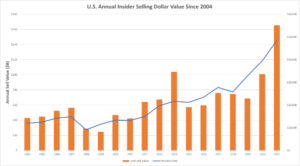
The Insider Review | January 2022
A monthly summary of notable insider trading activities from Verity’s Director of Research.
In Brief
- Insiders took advantage of December market volatility to buy.
- Dollar value of annual sales hit new high in 2021.
- Notable Cessation of Selling events happened at ARNA, CERN.
- Expect limited insider opportunities in January.
Macro: December Volatility Prompts Insider Activity
A choppy market in the middle of December gave insiders a last chance to buy in 2021 before quarterly trading windows closed. They took advantage of it — the number of buyers for the week ended December 21 was the second highest for the year.
Macro: ‘Super Sellers’ Push New Record High
There were plenty of insiders looking to generate liquidity and/or do some financial planning as the book closed on the year. While breadth and volume weren’t unusual for the time of the year, as the chart below shows, the dollar value of insider sales hit a new all-time high in 2021. December activity certainly played a role in that.
Insiders we termed “super sellers” such as Elon Musk at Tesla (TSLA), Satya Nadella at Microsoft (MSFT), and the Walton Family at Walmart (WMT) played an outsized role in pushing the dollar value of sales to a new high.
For more information, see the The Wall Street Journal’s examination of our data and analysis.

New High: The dollar value of insider sales hit a new all-time high in 2021. Source: VerityData
Worth Noting: Cessation of Selling Events
One datapoint we track closely at Verity are Cessation of Selling events. These proprietary events identify companies with robust insider selling cultures where insider selling has ceased, sending a positive valuation message in the process.
This company-wide change in insider behavior is often valuation-oriented (insiders believe the stock is undervalued and will wait for a higher price to return to their normal liquidity-generating behavior). But it can also be an indication of an imminent material event.
Two examples that indicated imminent material events emerged in December.
- Pfizer (PFE) announced a deal to acquire Arena Pharmaceuticals (ARNA) on December 13; or a little less than three weeks after we identified and flagged a Cessation of Selling event at ARNA to our customers.
- Meanwhile, at Cerner (CERN), we identified another Cessation of Selling event on December 15, or five days before Oracle (ORCL) announced it is buying the company.
Data Spotlight: Management Changes
Management changes can be another essential datapoint for both idea generation and risk management. In December 2021, seven companies announced CEO changes that involved the naming of an Interim CEO while another ten companies announced CFO changes that involved an interim replacement. The average performance of the 17 stocks in the six-month period ahead of those CEO and CFO changes was -35.6%.
Looking Ahead: Big Banks Kick Off Earnings Season, Insiders Follow
Insider activity is typically muted during the first half of January, picking up as earnings season kicks into gear with the big banks.
Because a large majority of companies report earnings in February or March, most insiders don’t have the opportunity to buy in the event of a January market swoon. This was most evident in 2016, when plunging oil prices and weak economic data out of China led to the NASDAQ’s worst month in six years. The only group of insiders who could take advantage of that market volatility ended up being bank insiders. They bought at prices that now represent six-year lows.
About the Data
Data included in this report is sourced by VerityData’s comprehensive databases of insider trades, buybacks, at-the-market offerings, management changes, institutional investor disclosures, and more.
For access, request a free trial of VerityData >>
For data inquiries relevant to this report, contact Ben Silverman.




Outperformance Starts Here
See how Verity accelerates winning investment decisions for the world's leading asset managers.
Request a Demo